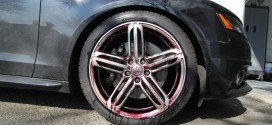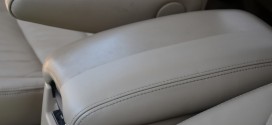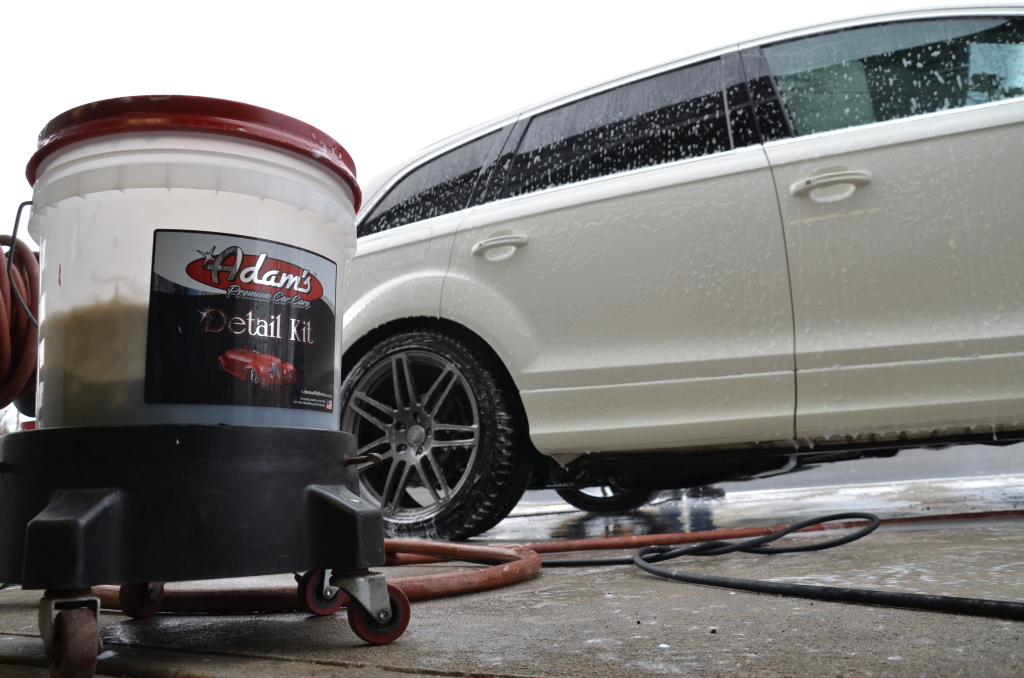|
SWIRL MARKS ARE OFTEN A NATURAL CONSEQUENCE OF THE JOB YOU ARE PERFORMING
If I mention “swirl marks” to you as a detailer, how do you react? Do you get the shakes, start to sweat, develop a nervous twitch? Some detailers view swirl marks as a major catastrophe, while others view them as a minor obstacle in completing a perfect job. The real problem occurs when a vehicle with remaining swirl marks is delivered to the customer: The detailer is viewed as unprofessional and/or incompetent. The customer is now hesitant to have the car detailed again, fearing the same results. This gives the industry as a whole a bad name. Unfortunately, detailers who have the skill and expertise to do the job correctly are grouped in the same category as those who do not. WHAT ARE SWIRL MARKS? Swirl marks, or buffer marks as some people refer to them, are circular cuts or abrasions in the paint surface. They take the form and reflect the diameter of the buffing pad and follow the direction in which the detailer was moving the buffer along the paint surface. Many times the area will have a reduced degree of gloss. These cuts and abrasions reflect light differently off the panels of the vehicle. The light will bounce off in various directions, instead of uniformly in one direction. You will see the most variance in direct sunlight. The gloss and clarity will be greatly affected because of these dreaded “swirl marks.” Unlike most light scratches (which can make their appearance anywhere on the vehicle), the swirl marks are unacceptable to customers because of their unnatural appearance, and because the customer “paid” for these results. HOW DID THEY GET THERE? Swirl marks are not a factory option, and they don’t just suddenly appear out of the blue. Somebody, in the process of trying to do something to the paint surface, put them there. Unfortunately, there are many reasons why swirls appear; * Choosing a buffing pad that is too aggressive is common. A heavy cut wool pad will inflict deep swirls on most clear-coat surfaces. In fact, the use of most wool pads on a clear-coat surface will leave swirl marks. In addition to these issues, there are other variables to consider. Know the model car you are working on. Has this make of vehicle given you trouble previously? Some vehicles are very easily scratched. It does not take a lot to put a mark in the paint surface. If you get to know how hard or soft the clear is, you can judge what can and can’t be done to the surface without leaving swirl marks. What exactly needs to be done to the paint surface? Are there major imperfections on or in the paint? Does it just need a polish and a wax? If you are not doing corrective procedures to the paint, you should utilize the least aggressive method possible. If you take account of all the factors that could impact the creation of swirl marks before you begin to work on the car, you can develop a game plan to do the job correctly. HOW TO CORRECTLY REMOVE SWIRLS. Once you realize that the swirl marks are there, you can determine what method to use to remove them. Often, you will leave swirls behind as a natural consequence of the job you are performing. For instance, a deep scratch has to be sanded or compounded to remove it. This will certainly cause swirls. Other examples are acid rain removal, or the elimination of scuffs and/or other blemishes. Most of the time, the first step in this process will be aggressive enough to leave swirl marks behind. Before you can take corrective action, you must identify what type of swirl you’re dealing with: Compound Swirl – This is a swirl mark that is cut deeper into the finish. It was probably brought about by a heavy cut wool pad, and a medium to heavy cut compound. Depending on the speed of the buffer at the time it was created, the swirl mark may be fairly deep into the surface. Polish Swirl – This type of swirl is still unsightly, but not as deep into the paint surface. This may have been created with a lighter wool pad, or even a light-cut foam pad. To remove swirl marks you must take your time; a number of steps may be necessary. If a vehicle has been heavily compounded to remove scratches, acid rain, haziness, or other imperfections from the paint, you may want to try a multi-step swirl-removal process. Your swirl remover product must have light cutting ability to level out the surface. You also must use a light cutting foam pad, or a genuine lambs wool pad as the first step. This first step may sometimes be necessary because the swirls may be fairly deep into the clear coat, and leveling them in two steps will ensure total removal. If you were to use just a polishing foam pad and a very light swirl-remover polish, you may not remove them completely, and they may reappear after a few washings. The second step in a deep-swirl removal process is the same as if the vehicle had light polish swirls to begin with. Use a foam pad with a PPI rating of about 80 (For more information about PPI ratings, see the article “Buffing Pads” in the November 1998 issue of Auto Laundry News). This type of pad will not cut so deeply and, as a result, will not put more swirls back into the surface. Run the high-speed buffer at no higher than 1,500 rpm. Remember, don’t be too aggressive with speed and heat in this step or you’ll defeat the whole purpose of the exercise. A true swirl remover product with some cutting or leveling ability will be the product of choice to use on the surface. Work in small sections at a time and move slowly over the area that you are buffing. You should be able to see the swirls disappear if you are doing it correctly. WHY ARE THEY STILL THERE? If the process was done correctly, the swirl marks will not come back. You have leveled out the surface and removed the swirl marks. The trouble some detailers have with swirls is this: 1. It is discouraging to take a vehicle into direct sunlight and discover on its finish swirl marks you thought you had successfully removed, or, worse, having an unhappy customer bring the vehicle back when he finds the marks. By far the worst, though, is the customer who discovers the marks, but does not bring the car back — ever — because he views you as an unprofessional incompetent. GO AWAY AND NEVER COME BACK! There is an age-old method of quality control you can employ when removing swirl marks. Fill a spray bottle with a 50/50 mix of isopropyl alcohol and water. Spray the surface you have just completed and let the solution sit for approximately 15 seconds. Wipe the area with a clean soft towel and observe. What you have done is remove any silicone, wax, and oils that may have filled the swirls instead of eliminating them. This is where the halogen lights come in handy. Shine the light directly on the panel and look for fine swirls. If they are still present, you should be able to see them. If you have done the job correctly, you will see a clear, bright reflection off the panel with a great shine, depth, and clarity. This finish says the swirls are gone. DON’T LET THE COLOR FOOL YOU We all know that swirl marks are more easily visible on dark colored cars. You actually see the swirls in the clear coat but the dark background color (the base coat) is a good backdrop. Don’t get lazy and skip a step because you may be working on a light colored vehicle. You may have to look a little harder, but you will see swirls on a light color. A customer with a good eye will see them, too. Remember that you are buffing the clear, and the same steps and procedures should be followed regardless of the vehicle color. DON’T BE AFRAID Don’t be afraid of swirl marks. Sometimes the biggest mistake you can make when detailing a vehicle is being too timid with the paint. If the surface needs to be cut into, there is a good chance that some kind of swirl mark will be left behind. If you do not give the paint surface what it needs to look its best because you are afraid of leaving behind swirl marks, you are cheating both yourself and the customer. Don’t worry about swirl marks. Be aware of them but don’t be afraid of them. If you are not being paid for a multi-step procedure, try not to use a wool pad. Most of the time, this type of pad will leave behind swirl marks to some degree. If a one-step procedure is being used, employ a finishing foam pad on the high-speed buffer, or use an orbital machine to polish the vehicle. The key in the buffing process is to know how the paint will react to each step you are performing. Once you know that swirl marks are fairly easy to remove, you will have the confidence to do what the car needs. Kevin Farrell owns and operates Kleen Car |
Check Also
Don’t wash your ride with dish detergent!
Why use car shampoo when I can use dishwashing detergent or lower cost car shampoos? …
 Detailer's Domain The Source for All Your Car Care Needs
Detailer's Domain The Source for All Your Car Care Needs




have a 09 370Z has swirl marks and fine little scratches (ridiculous for a car with 1800 miles). Paint color magnetic Black. i think this factory paint it very soft. Do you know anyone in the tampa bay area that does actual Concours detailing? I would appreciate any direction you can give.
there are plenty of good detailers on http://www.detailingbliss.com